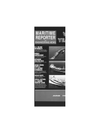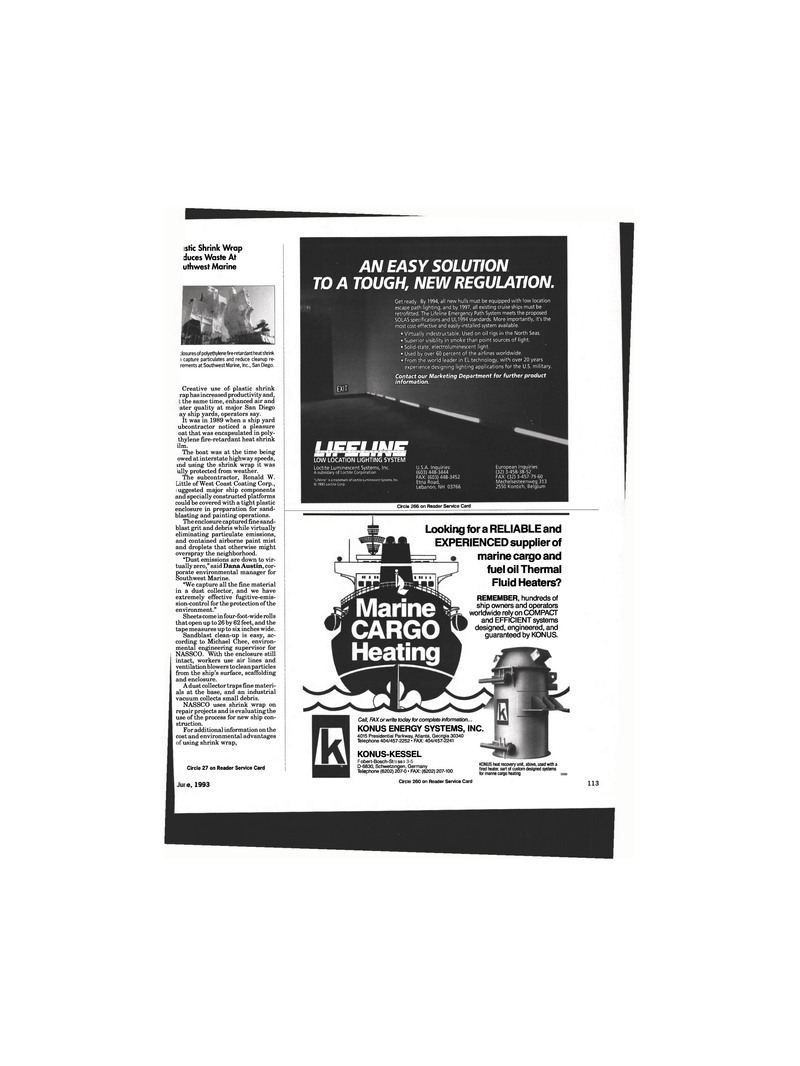
Page 112: of Maritime Reporter Magazine (June 1993)
Read this page in Pdf, Flash or Html5 edition of June 1993 Maritime Reporter Magazine
istic Shrink Wrap duces Waste At uthwest Marine :losures of polyethylene fire-retardant heat shrink 1 capture particulates and reduce cleanup re- rements at Southwest Marine, Inc., San Diego.
Creative use of plastic shrink rap has increased productivity and, the same time, enhanced air and ater quality at major San Diego ay ship yards, operators say.
It was in 1989 when a ship yard ubcontractor noticed a pleasure oat that was encapsulated in poly- thylene fire-retardant heat shrink ilm.
The boat was at the time being owed at interstate highway speeds, ind using the shrink wrap it was ully protected from weather.
The subcontractor, Ronald W.
Little of West Coast Coating Corp., uggested major ship components and specially constructed platforms could be covered with a tight plastic enclosure in preparation for sand- blasting and painting operations.
The enclosure captured fine sand- blast grit and debris while virtually eliminating particulate emissions, and contained airborne paint mist and droplets that otherwise might overspray the neighborhood. "Dust emissions are down to vir- tually zero," said Dana Austin, cor- porate environmental manager for
Southwest Marine. "We capture all the fine material in a dust collector, and we have extremely effective fugitive-emis- sion-control for the protection of the environment."
Sheets come in four-foot-wide rolls that open up to 26 by 62 feet, and the tape measures up to six inches wide.
Sandblast clean-up is easy, ac- cording to Michael Chee, environ- mental engineering supervisor for
NASSCO. With the enclosure still intact, workers use air lines and ventilation blowers to clean particles from the ship's surface, scaffolding and enclosure.
A dust collector traps fine materi- als at the base, and an industrial vacuum collects small debris.
NASSCO uses shrink wrap on repair projects and is evaluating the use of the process for new ship con- struction.
For additional information on the cost and environmental advantages using shrink wrap,
Circle 27 on Reader Service Card ie, 1993
AN EASY SOLUTION TO A TOUGH, NEW REGULATION.
Get ready. By 1994, all new hulls must be equipped with low location escape path lighting, and by 1997, all existing cruise ships must be retrofitted. The Lifeline Emergency Path System meets the proposed
SOLAS specifications and UL1994 standards. More importantly, it's the most cost-effective and easily-installed system available. • Virtually indestructable. Used on oil rigs in the North Seas. • Superior visiblity in smoke than point sources of light. • Solid-state, electroluminescent light. • Used by over 60 percent of the airlines worldwide. • From the world leader in EL technology, with over 20 years experience designing lighting applications for the U.S. military.
Contact our Marketing Department for further product information.
EXIT itUFtELMAHE
LOW LOCATION LIGHTING SYSTEM
Loctite Luminescent Systems, Inc.
A subsidary of Loctite Corporation "Lifeline" is a trademark of Loctite Luminescent Systems, Inc. © 1993 Loctite Corp.
U.S.A. Inquiries: (603) 448-3444
FAX: (603) 448-3452
Etna Road,
Lebanon, NH 03766
European Inquiries: (32) 3-458-38-52
FAX: (32) 3-457-79-60
Mechelsesteenweg 313 2550 Kontich, Belgium
Circle 266 on Reader Service Card
Looking for a RELIABLE and
EXPERIENCED supplier of marine cargo and fuel oil Thermal
Fluid Heaters?
REMEMBER, hundreds of ship owners and operators worldwide rely on COMPACT and EFFICIENT systems designed, engineered, and guaranteed by KONUS.
Call, FAX or write today for complete information...
KONUS ENERGY SYSTEMS, INC. 4015 Presidential Parkway, Atlanta, Georgia 30340
Telephone 404/457-2252 • FAX: 404/457-2241
KONUS-KESSEL
DtlStlingln,Germany ffffSlg^S
Telephone (6202) 207-0 • FAX: (6202) 207-100 for manne cargo heating
Circle 260 on Reader Service Card

 111
111

 113
113
